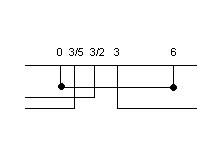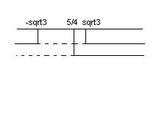[math]\sqrt{6x-x^2}>3-2x[/math]
[math]\sqrt{6x-x^2}>3-2x[/math]
;
Essa è del tipo
[math]\sqrt{f(x)}>g(x)[/math]
ed è quindi equivalente al sistema
[math]\begin{cases} f(x) \geq 0 \\ g(x)>0 \\ f(x)>[g(x)]^2 \ \end{cases}[/math]
;
Nel nostro caso
[math]f(x)=(6x-x^{2})^{g(x)}=3-2x[/math]
.
Quindi la disequazione è equivalente al sistema:
[math]\begin{cases} 6x-x^2 \geq 0 \\ 6x-x^2>(3-2x)^2 \\ 3-2x>0 \ \end{cases}[/math]
;
[math]\begin{cases} 6x-x^2 \geq 0 \\ 6x-x^2>9+4x^2-12x \\ -2x> -3 \ \end{cases}[/math]
;
[math]\begin{cases} 6x-x^2 \geq 0 \\ -5x^2-9+18x>0 \\ x>3/2 \ \end{cases}[/math]
;
[math]\begin{cases} 6x-x^2 \geq 0 \\ 5x^2-18x+9>0 \\ x>3/2 \ \end{cases}[/math]
;
Studiamo singolarmente le prime due
disequazioni:
1)
[math]6x-x^2 \geq 0[/math]
;
[math]x(6-x) \geq 0 \rightarrow x \geq 0 _ 6-x \geq 0[/math]
.
Quindi soluzione della disequazione sarà:
[math]S_1={0 \leq x \leq 6}[/math]
.
2)
[math]5x^2-18x+9>0[/math]
[math](\Delta)/4=(b/2)^2-ac=(-9)^2-(9 \cdot 5)=81-45=36[/math]
[math]x_(1,2)=(-b/2+-\sqrt{(\Delta)/4})/a=(9+-\sqrt(36))/5=(9+-6)/5 \rightarrow x_1=3 ^ x_2=3/5[/math]
.
Siccome il segno del coefficiente di
[math]x^2[/math]
è concorde col segno della disequazione,
prenderemo gli intervalli esterni, quindi soluzione della disequazione sarà:
[math]S_2={x \leq 3/5 _ x \geq 3}[/math]
.
Intersechiamo, ora, le soluzioni trovate e otterremo la soluzione finale del sistema

[math]S={0 \leq x>3/5}[/math]
.










 Accedi a tutti gli appunti
Accedi a tutti gli appunti
 Tutor AI: studia meglio e in meno tempo
Tutor AI: studia meglio e in meno tempo